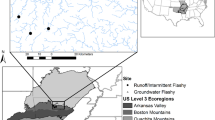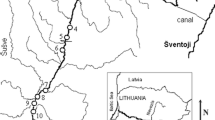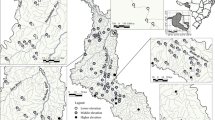Abstract
Fish habitat use during summer was examined at micro- and meso-levels, to determine species associations in the upper Roanoke River watershed, Virginia. Based on multivariate-mesohabitat analysis and examination of mean microhabitat use, seven habitat-use guilds were apparent. These included four rheophilic (fast-riffle, riffle/run, fast-generalist, and shallow-rheophilic) and three limnophilic guilds (pool/run, open-pool, and pool-cover) that were reasonably robust across two river segments and two years. Although simple-hydraulic, bottom-topographic, and turbulence variables all segregated fish habitat-use guilds, turbulence variables were redundant with simple-hydraulic variables, substratum use by limnophilic fishes was related to availability, and only one guild consistently selected high cover levels. At the family level, suckers, darters, and especially minnows were notable for occupying several habitat-use guilds, because of species differences in habitat preferences. Such formulation of guilds can simplify habitat-impact analyses in biodiverse, warmwater streams, via focus on habitat needs of guilds rather than on individual species.
Similar content being viewed by others
References cited
Aadland, L.P. 1993. Stream habitat types: their fish communities and relationship to flow. N. Amer. J. Fish. Manage. 13: 790–806.
Angermeier, P.L. 1987. Spatiotemporal variation in habitat selection by fishes in small Illinois streams. pp. 52–60. In: W.J. Matthews & D.C. Heins (ed.) Community and Evolutionary Ecology of North American Stream Fishes, University of Oklahoma Press, Norman.
Austen, D.J., P.B. Bayley & B.W. Menzel. 1994. Importance of the guild concept to fisheries research and management. Fisheries 19(6): 12–20.
Backiel, T. & R.L. Welcomme (eds). 1980. Guidelines for sampling fish in inland waters. EIFAC (Europ. Inland Fish. Advisory Commiss.) Tech. Pap. 33. 176 pp.
Bain, M.B. & J.M. Boltz. 1989. Regulated streamflow and warmwater stream fish: a general hypothesis and research agenda. U.S. Fish Wildl. Serv. Biol. Rep. 89(18). 28 pp.
Bain, M.B. & J.G. Knight. 1996. Classifying stream habitat using fish community analyses. pp. B107–B117. In: M. Leclerc, H. Capra, S. Valentin, A. Boudreault & Y. Côté (ed.) Ecohydraulics 2000, Vol. B, Institut National de la Recherche Scientifique, Eau.
Balon, E.K. 1981. About processes which cause evolution of guilds and species. Env. Biol. Fish. 6: 129–138.
Bart, H.L. Jr. 1989. Fish-habitat association in an Ozark stream. Env. Biol. Fish. 24: 173–186.
Connelly, W.J., D.J. Orth & R.K. Smith. 1999. Habitat of the riverweed darter, Etheostoma podostemone Jordan, and the decline of riverweed, Podostemone ceratophyllum, in the tributaries of the Roanoke River, Virginia. J. Freshw. Ecol. 14: 93–102.
Dolloff, C.A. 1987. Seasonal population characteristics and habitat use by juvenile coho salmon in a small southeast Alaska stream. Trans. Amer. Fish. Soc. 116: 829–838.
Douglas, M.E. 1987. An ecomorphological analysis of niche packing and niche dispersion in stream-fish clades. pp. 144–149 In: W.J. Matthews & D.C. Heins (ed.) Community and Evolutionary Ecology of North American Stream Fishes, University of Oklahoma Press, Norman.
Douglas, M.E. & W.J. Matthews. 1992. Does morphology predict ecology? Hypothesis testing within a freshwater stream fish community. Oikos 65: 213–224.
Fausch, K.D., J. Lyons, J.R. Karr & P.L. Angermeier. 1990. Fish communities as indicators of environmental degradation. Amer. Fish. Soc. Symp. 8: 123–144.
Gordon, N.D., T.A. McMahon & B.L. Finlayson. 1992. Stream hydrology: an introduction for ecologists. John Wiley & Sons, New York. 526 pp.
Gore, J.A. & J.M. Nestler. 1988. Instream flow studies in perspective. Reg. Rivers Res. Manage. 2: 93–101.
Groshens, T.P. & D.J. Orth. 1993. An assessment of the transferability of habitat suitability criteria for smallmouth bass. Va. Wat. Resour. Res. Center Bull. 180. 104 pp.
Grossman, G.D. & M.C. Freeman. 1987. Microhabitat use in a stream fish community. J. Zool. Lond. 212: 151–176.
Hawkins, C.P., L.J. Gottschalk & S.S. Brown. 1988. Densities and habitat of tailed frog tadpoles in small streams near Mt. St. Helens following the 1980 eruption. J. N. Amer. Benthol. Soc. 7: 246–252.
Helfrich, L.A., K.W. Nutt & D.L.Weigmann. 1991. Habitat selection by spawning redbreast sunfish in Virginia streams. Rivers 2: 138–147.
Herbold, B. 1984. Structure of an Indiana fish association: choosing an appropriate model. Amer. Nat. 124: 561–572.
Jaksić, F.M. 1981. Abuse and misuse of the term 'guild' in ecological studies. Oikos 37: 397–400.
Jenkins, R.E. & N.M. Burkhead. 1994. Freshwater fishes of Virginia. American Fisheries Society, Bethesda. 1079 pp.
Jenkins, R.E. & C.A. Freeman. 1972. Longitudinal distribution and habitat of the fishes of Mason Creek, an upper Roanoke River drainage tributary, Virginia. Va. J. Sci. 23: 194–202.
Jordan, D.S. 1888. Report of explorations made during the summer and autumn of 1888, in the Alleghany region of Virginia, North Carolina and Tennessee, and in western Indiana, with an account of the fishes found in each of the river basins of those regions. Bull. U.S. Fish. Commiss. 8: 97–173.
Kandem Toham, A. & G.G. Teugels. 1997. Patterns of microhabitat use among fourteen abundant fishes of the lower Ntem River Basin (Cameroon). Aquat. Liv. Resour. 10: 289–298.
Larimore, R.W. & D.D. Garrels. 1985. Assessing habitats used by warmwater stream fishes. Fisheries 10(2): 10–16.
Lee, D.S. 1977. The darters of Maryland. Md. Cons. 53(4): 18–23.
Leonard, P.M. & D.J. Orth. 1988. Use of habitat guilds of fishes to determine instream flow requirements. N. Amer. J. Fish. Manage. 8: 399–409.
Lobb, M.D. III & D.J. Orth. 1991. Habitat use by an community of fish in a large warmwater stream. Trans. Amer. Fish. Soc. 120: 65–78.
Lukas, J.A. & D.J. Orth. 1993. Reproductive ecology of redbreast sunfish Lepomis auritus in a Virginia stream. J. Freshw. Ecol. 8: 235–244.
Matthews, W.J. 1985. Critical current speeds and microhabitats of the benthic fishes Percina roanoka and Etheostoma flabellare. Env. Biol. Fish. 12: 303–308.
Matthews, W.J., J.R. Bek & E. Surat. 1982. Comparative ecology of the darters Etheostoma podostemone, E. flabellare, and Percina roanoka in the upper RoanokeRiver drainage,Virginia. Copeia 1982: 805–814.
McNeely, D.L. 1987. Niche relations within an Ozark stream cyprinid community. Env. Biol. Fish. 18: 195–208.
Meffe, G.K. & A.L. Sheldon. 1988. The influence of habitat structure on fish community composition in southeastern blackwater streams. Amer. Midl. Nat. 120: 225–240.
Moyle, P.B. & H.W. Li. 1979. Community ecology and predator-prey relations in warmwater streams. pp. 171–180. In: R.H. Stroud & H. Clepper (ed.) Predator-Prey Systems in Fisheries Management, Sport Fishing Institute, Washington, D.C.
Orth, D.J. 1987. Ecological considerations in the development and application of instream flow-habitat models. Reg. Rivers Res. Manage. 1: 171–181.
Orth, D.J. 1995. Food web influences on fish population responses to instream flow. Bull. Fr. Peche Piscic. 337–339: 317–328.
Rinne, J.N. 1985. Physical habitat evaluation of small stream fishes: point vs. transect, observation vs. capture methodologies. J. Freshw. Ecol. 3: 121–131.
Roberts, T.H. & L.J. O'Neil. 1985. Species selection for habitat assessments. Trans. N. Amer. Wildl. Nat. Resour. Conf. 50: 352–362.
Shaw, E. 1978. Schooling fishes. Amer. Sci. 66: 166–175.
Surat, E.M., W.J. Matthews & J.R. Bek. 1982. Comparative ecology of Notropis albeolus, N. ardens, and N. cerasinus (Cyprinidae) in the upper Roanoke River drainage, Virginia. Amer. Midl. Nat. 107: 13–24.
Taylor, C.M., M.R. Winston & W.J. Matthews. 1993. Fish species-environment and abundance relationships in a Great Plains river system. Ecography 16: 16–23.
Vadas, R.L., Jr. 1992. Seasonal habitat use, species associations, and community structure of forage fishes in Goose Creek, northern Virginia. II. Mesohabitat patterns. J. Freshw. Ecol. 7: 149–164.
Vadas, R.L. Jr. 1994. Habitat tools for assessing instream-flow needs for fishes in the upper Roanoke River, Virginia. Ph.D. Dissertation, Virginia Polytechnic Institute and State University, Blacksburg. 346 pp.
Vadas, R.L., Jr. & D.J. Orth. 1993. Anewtechnique for estimating the abundance and habitat use of stream fishes. J. Freshw. Ecol. 8: 305–317.
Vadas, R.L. Jr. & D.J. Orth. 1997. Species associations and habitat use of stream fishes: the effects of unaggregated-data analysis. J. Freshw. Ecol. 12: 27–37.
Vadas, R.L. Jr. & D.J. Orth. 1998. Use of physical variables to discriminate visually determined mesohabitat types in North American streams. Rivers 6: 143–159.
Vadas, R.L. Jr. & D.J. Orth. 2000. Formulation of habitat suitability models for stream-fish guilds: do the standard methods work? Trans. Amer. Fish. Soc. (in press).
Vadas, R.L. Jr. & D.L. Weigmann. 1993. The concept of instream flow and its relevance to drought management in the James River basin. Va. Wat. Resour. Res. Center Bull. 178. 78 pp.
Whittier, T.R. & D.L. Miller. 1986. Stream fish communities revisted: a case of mistaken identity. Amer. Nat. 128: 433–437.
Author information
Authors and Affiliations
Rights and permissions
About this article
Cite this article
Vadas, R.L., Vadas, R.L. & Orth, D.J. Habitat Use of Fish Communities in A Virginia Stream System. Environmental Biology of Fishes 59, 253–269 (2000). https://doi.org/10.1023/A:1007613701843
Issue Date:
DOI: https://doi.org/10.1023/A:1007613701843




